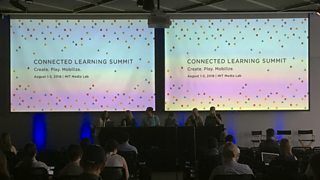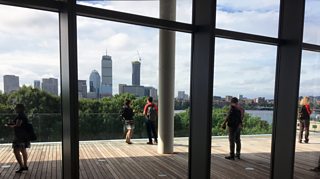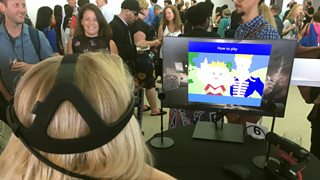Learning through technology, with the help of old-fashioned human contact
Charles Miller
edits this blog. Twitter: @chblm

First impressions of the in Boston: it’s bigger, smarter and has better coffee and snacks – zucchini muffins! – than the equivalent gatherings in the UK.
Three days of talks and demos are promised in the plush surroundings of the MIT Media Lab. Before the first session I chat to a media consultant from Tokyo, a woman running a community learning organisation in Chicago and the founder of a learning startup, who, with her friend, a media professor, has driven for seven hours across New England to be here. It’s an eclectic mix.
The conference announces itself as the first annual Connected Learning Summit (slogan: Create. Play. Mobilize.) Its tone and subject area are defined in the first event, a conversation between the director of the MIT Media Lab, and (“Futurist comedian, writer, activist”).
Baratunde explains why he's speaking at the Massachusetts Institute of Technology, apologising that he’s only half-qualified: “I was one of those kids who loved to take things apart. But I could never put them together again.” He describes the importance of humour as a bridge-building tool in learning: “laughter is a leading indicator of effective communication …you can’t shape the world if nobody is engaging.”

Boston, from the MIT Media Lab
Designing experiences to engage learners is what the conference is all about. “I don’t teach,” a teacher says, “I just create an environment in which learning can take place.” And the conference is full of evidence that this approach can produce impressive results. There are people who work with schools, museums and with minority groups, using technology to help explore science, the environment or local history. In many sessions, project leaders report heart-warming outcomes.
But whether they’re using tablets, VR headsets, location-based apps or online tools, these techie approaches to learning are all labour-intensive. I don’t think I saw one idea that looked like it would pay for itself as a startup business - because they all needed too much human love and attention to make the good things happen.
So technology isn’t an easy fix for helping the under-served groups that the conference was interested in. But if tech doesn’t provide a quick - or cheap - fix, at least it’s good to know that old-fashioned human interaction and one-to-one attention is still a valuable commodity in today's AI-driven world.
I was there to talk about the , a VR project I produced which is designed to give a first taste of television studio directing to anyone who thinks it’s a skill they’d like to learn. I gave people a chance to try it out and had some enthusiastic responses: what I like best is when someone gets a low feedback score and is so determined to try again straight away that they don’t care about other people waiting to have a turn.

Trying the 成人论坛 Academy Studio Directing Experience
The studio directing project was one of many VR and AR (augmented reality) initiatives presented at the conference. The technology is no longer a novelty, though it’s still evolving fast, moving towards lighter, untethered headsets which will soon make existing hardware seem quaintly cumbersome.
If the hardware problems of VR are on the way to being solved, one impressive project pointed the way towards solving the social problems of VR too. Today, you feel isolated during a VR experience, which isn’t great for use in a classroom or group training setting. Julian Korzeniowsky, one of five developers on a Carnegie Mellon Entertainment Technology Center graduate program, talked about his project, a classroom experiment in which children in a science class are put in a virtual world together and given tasks by a teacher who monitors the group using an iPad. gives a good account of the challenges and the results. If groups of learners can work together rather than being in separate virtual worlds, the possibilities multiply. As progress continues in both VR hardware and software, school 'trips' could be more imaginative, cheaper and easier to organise than those in the real world are.
Collaboration was a theme of the conference. by Ted Barnett, a Silicon Valley executive, invites groups of school children to work together to build historically-accurate 3-D models of their home town. They start with old photographs and use a variety of software tools to turn them into a model of the town in - which can then be navigated with movement that can be recorded.
Similarly, a discussion of the use of Minecraft (now owned by Microsoft and available in an ) in classrooms raised possibilities for collaboration. One teacher showed a Minecraft model that his pupils had built of the psychiatric unit from One Flew Over the Cuckoo’s Nest, which they were studying.
There must be opportunities for the 成人论坛 Academy to use technology to encourage more collaborative work by groups of learners. After all, everyone operates as part of a group in their work.
It was a big, busy conference, and participants were constantly having to choose what to see and what to miss. If I had my time again, perhaps I would have fitted in the talk on User-Generated Meal Photos as a Benchmark for Nutritional Estimation; or even the one on Managing Randomness and Collectible Card Game Playing as Collective Cognitive Achievement. I did attend and enjoy a talk by an academic who’s made it his business to watch or read every single incarnation of Star Wars - movies, TV series, novels, comics and plenty else - as a study in “transmedia” culture. It’s taken him two years and he reckons he’s still got about five per cent of the material still to go.

Now that's what I call a classy conference breakfast
Apart from better funding, there are a couple of other ideas that British conference organisers could adopt from Connected Learning. First, for the Q and A at the end of a session, why not just set up a mic in the middle of an aisle and invite people to form a queue behind it to ask questions? It avoids all the business of pointing and passing a mic to “the man at the back, no not you…” Second, it’s a great idea to cut down on the warm welcomes and other time-wasting by big cheeses at the start of a conference and get straight down to business.
Finally, a two hour lunch break looked over-generous, but everyone soon found themselves having interesting chats with random strangers. We learnt and we connected - which is what Connected Learning 2018 was all about.
